This publication covers the history of satsuma mandarins, and a list of their cultivars describes the various physical characteristics of each plant and resulting fruit. This publication is intended to educate students and potential mandarin growers, as well as inform Extension agents and any interested persons of the public.
Scientific Name
Citrus unshiu Marcovitch
Common Name
In most citrus producing areas, satsuma mandarin is the preferred name, but satsuma tangerine is also used (Figures 1 and 2).
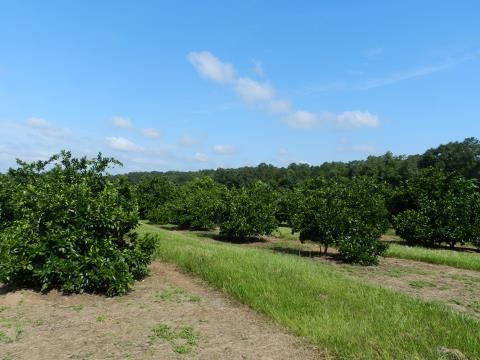
Credit: P. C. Andersen, UF/IFAS
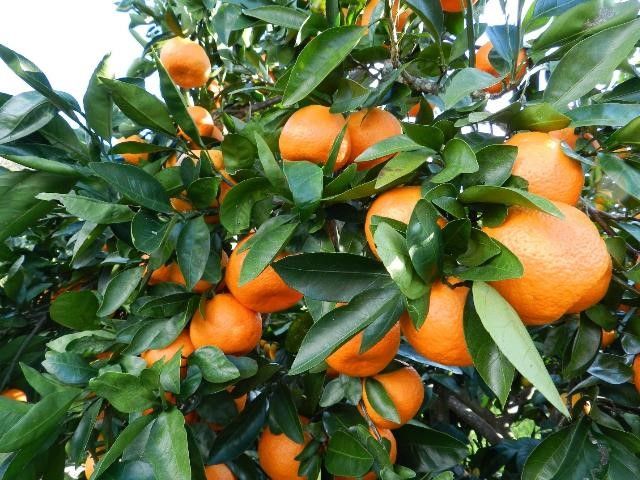
Credit: P. C. Andersen, UF/IFAS
Family
Rutaceae (Also known as Rue)
Origin
China and Japan
History
Satsuma mandarin may have originated in China, but it was first reported in Japan more than 700 years ago, where it is now the major citrus species grown. They are named from the Satsuma Province in Japan, which is located on the southwestern-most tip known as present-day Kyushu. The first recorded introduction into the United States was in Florida by George R. Hall in 1876. 'Owari' is the primary satsuma cultivar commercially grown in Florida. Other known cultivars such as 'Brown Select', 'Early St. Ann', 'Silverhill', and 'Kimbrough' are available as well but not on the same scale as the ‘Owari’.
Between 1908 and 1911, approximately a million 'Owari' satsuma trees were imported from Japan and planted throughout the lower Gulf Coast states— from the northern Florida Gulf coast to Texas— developing an extensive tangerine industry. Despite severe freezes having occasionally reduced satsuma acreage in these northern areas, the satsuma mandarin is a major commercial citrus type grown in the southern parts of the states bordering the northern Gulf of Mexico.
Distribution
Satsumas are grown in cool subtropical regions of Japan, Spain, central China, Korea, Turkey, along the Black Sea in Russia, southern South Africa, South America, and on a small scale in central California and northern Florida. The world's largest satsuma industry is in southern Japan where climatic conditions are favorable for the production of high quality, early ripening satsuma mandarins. Selection of slight mutations and seedlings from controlled pollinations over many years has resulted in a collection of over 100 cultivars that differ in date of maturity, fruit shape, color, and quality.
Importance
While this fruit is grown primarily for fresh consumption, a portion of the crop is canned as fruit segments or juice in Japan, China, and Spain. In these countries deeply colored juice is blended with orange juice to improve color or sold as single-strength tangerine juice. Fresh fruit is also imported into Canada and non-citrus producing areas of the United States, where it is the earliest seasonal citrus crop to reach the market.
Description
Although authorities differ as to the number of species and appropriate classification and grouping, mandarins have been divided into four groups: 1) Satsuma group (Citrus unshiu), 2) the King group (C. nobilis), 3) the Mediterranean group (C. deliciosa), and 4) the common group (C. reticulata).
Tree
Budded trees are small to medium-small, low-growing, usually spreading and drooping, and nearly thornless. They also have less foliage and a more open growth habit than other commercial citrus cultivars. Trees have a prostrate growth habit, meaning they grow flat on the soil surface, touching the ground, but not trailing it. So, low-lying limbs must be pruned to prevent fruit from lying on the ground. Trees are very hardy to cold and resistant to unfavorable conditions but susceptible to Elsinoe fawcetti— a fungal disease that causes citrus scabbing, wart-like lesions on leaves, twigs, and fruit without usually affecting internal fruit quality.
Leaves
Leaves are dark green, large, lanceolate, and tapering at the base and apex. They are typically broader than the leaves of other tangerines. Both main and primary lateral veins are prominent above as well as below. The petiole is slender, very long, and narrowly winged.
Flowers
Petals of the flower are white, and the flowers are "perfect," containing both male and female flower parts (Figure 5). Satsuma flowers produce little viable pollen and have few viable ovules. However, the satsuma does not require pollination and is highly parthenocarpic— develops fruit without fertilization, resulting in seedless fruit.
Fruit
Botanically, the fruit of tangerines, and of all citrus species, is known as hesperidium, a type of modified berry. These fruit are medium to small, are shaped like a flattened sphere, and sometimes appear slightly necked. They are most commonly seedless (0 to 6 seeds), and when present, these seeds have light green cotyledons. They also have tough carpellary membranes and a hollow axis with pulp-vesicles that are short and broad. Typically, in areas with cool night temperatures, the flesh is a brilliant reddish-orange, tender and melting, with a rich and subacid flavor.
Fruit Quality
Satsumas are consistently high quality in regions with cool winters and hot summers (Figure 3). Fruit grown in humid subtropical areas commonly mature internally and have good eating quality before good peel color develops.
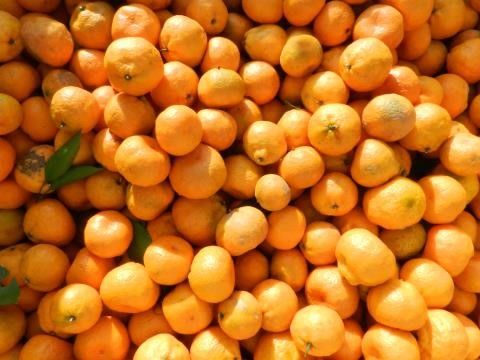
Credit: P. C. Andersen, UF/IFAS
Such internally mature but externally green fruit is sometimes marketed as Emerald Green satsuma tangerines (Figure 4).
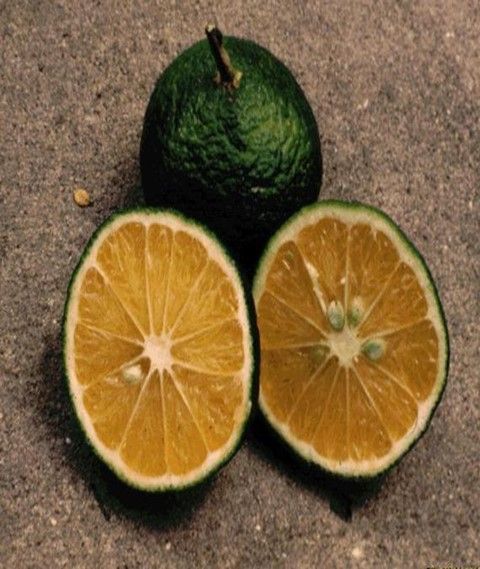
Credit: UF/IFAS
The rind is thin and somewhat leathery; it is moderately smooth with large and prominent oil glands. As for any fruit intended for the fresh market, to preserve high peel quality, clip fruit at harvest to avoid plugging or tearing, which may subsequently result in postharvest decay.
As fruit matures, the rind surface becomes increasingly bumpy, and the rind separates from the flesh somewhat. Fruit like this do not tolerate careless handling, do not respond well to degreening, and in general, do not ship well.
Cold Tolerance
The Satsuma mandarin tree is the most cold-tolerant citrus of commercial importance. Mature dormant trees have survived minimum temperatures of 14°F–18°F in northern Florida, northern California, and southern Alabama without serious injury. Moreover, because of their low total heat requirement, some satsumas ripen earlier than oranges and most other mandarins. Consequently, the satsuma mandarin is ideally adapted to regions with winters too cold for other citrus fruits but with growing seasons warm enough to produce early maturity and good quality fruit. Its range of climatic adaption for commercial culture is, therefore, narrow and restricted to the higher elevations and colder areas of the sub-tropical zones. In the United States, climatic conditions suitable for satsumas occur in northern Florida, in a narrow strip extending along the Gulf of Mexico across Alabama, Mississippi, and Louisiana into eastern Texas and in the Sacramento-San Joaquin Valley basin of California. Although these areas are subject to severe freezes, current cold protection methods, using in-tree micro sprinklers, can protect trees to a height of approximately five feet. In addition, tree trunks can be mounded with soil up to a height of two feet during early December to protect the region above the graft union. Remember to remove the mound from the base of the plant by mid-March. Commercial trunk wraps may also provide some cold protection. These strategies may be the key to at least partial revitalization of satsuma plantings in some areas.
Bearing Season
Season of maturity: September to December. Fruit hold poorly on the tree after maturity, must be picked promptly, but stores well under refrigerated conditions between 32°F–36°F.
Cultivars
Below is a list of the common cultivars, that are grown in Florida with an explanation of their characteristics.
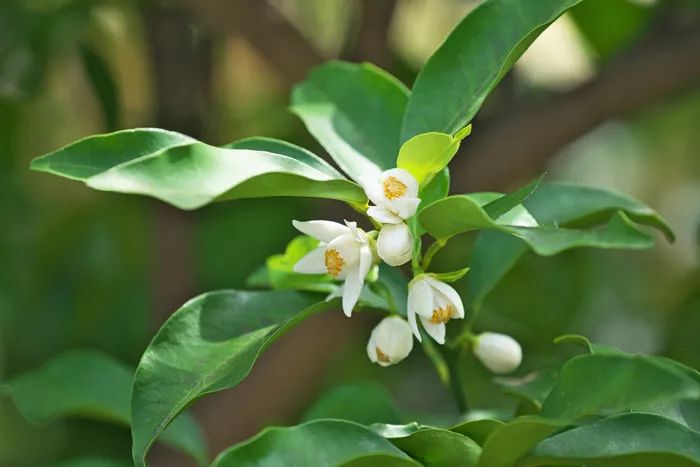
Credit: Peg Aloi/Getty Images
'Owari' Satsuma. Season of maturity: October to November. Seeds: 0–6, but rarely present. As the fruit matures, the neck, if present, increases in size, and the rind roughens and loosens. Fruit quality is good and, because of the firm consistency of the flesh and tough carpellary membranes, is especially suitable for canning (Figure 6). Trees are moderately vigorous, very productive, but slow-growing; they produce medium-small sized fruit on branches which are spreading and drooping.
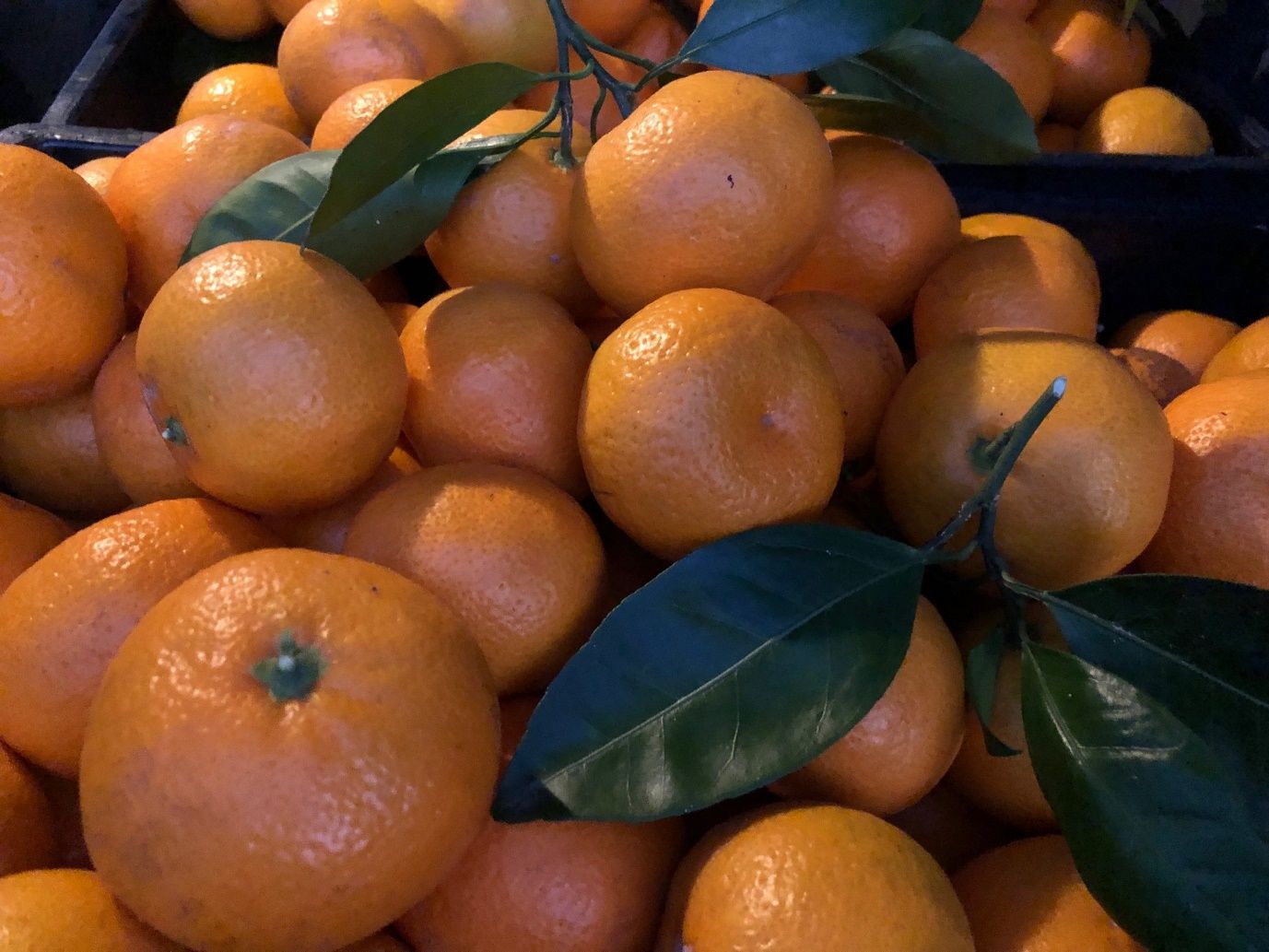
Credit: Jake Price, UGA Extension Lowndes
'Silverhill' Satsuma. Season of maturity: October to November. Seeds: 0–6, but rarely present. Fruit are medium in size and slightly more oblate (concave on some sides) in shape than most other cultivar fruits with abundant juice, usually containing high sugars and low acid, tasting very sweet. The rind is relatively thin and smooth. Trees are very vigorous, productive, and more up-right than other satsuma cultivars (Figure 7).
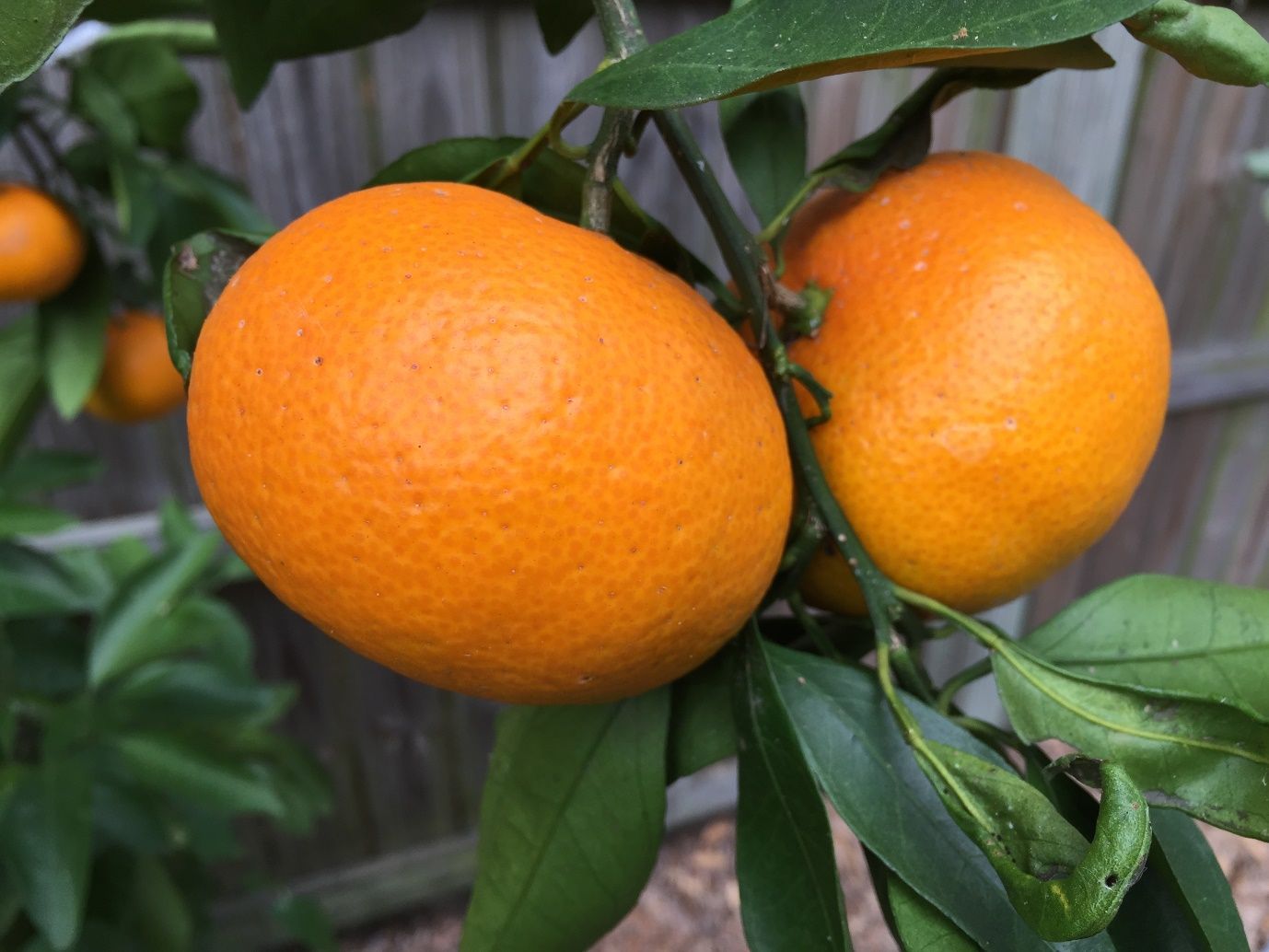
Credit: Jake Price, UGA Extension, Lowndes County
'Kimbrough' Satsuma. Season of maturity: October to November. Seeds: 0–6, but rarely present. Introduced from Louisiana, this cultivar produces larger fruit than the 'Owari' satsuma, with rind thickness, internal color, taste, and fruit production comparable to 'Owari'. Trees are large and productive with a spreading growth habit. They are thought to offer 1°F–2°F better cold tolerance than 'Owari'.
'Brown Select' Satsuma. Season of maturity: October to November (two weeks ahead of 'Owari'). Seeds: 0–6, but rarely present. ‘Brown Select’ is originated from the Louisiana Citrus Research Center. It is as an open-pollinated seedling of 'Kimbrough'. Tree size is slightly larger than 'Owari'. 'Brown Select' has a compact or dense growth habit and is less weepy than some of the other satsuma cultivars. At harvest, the skin is leathery and easily separates from the flesh. Fruit color is yellow orange, the flesh is orange, and the fruit taste is acidic-sweet (Figure 8).

Credit: Kim Jones, Florida Georgia Citrus, Monticello, FL
'Early St. Ann' Satsuma. Season of maturity: Late September to October. Seeds: 0–6, but rarely present. 'Early St. Ann' is a cultivar that originated from the Louisiana Citrus Research Center. It is an open-pollinated seedling of unknown parentage. It ripens extremely early, from mid-September to mid-October. Growth habit is droopy, as is the case with most satsuma cultivars. 'Early St. Ann' fruit are medium-large in size and light yellow in color. At harvest, the skin is leathery and easily separates from the flesh. Flesh color is deep orange, and the taste is juicy and mildly acidic.
'Xie Shan' Satsuma. Season of maturity: Late September through October. Seeds: 0–6, but rarely present. This cultivar is a relatively new introduction from China. Trees are slightly smaller than 'Owari' trees of the same age. Growth habit is spreading and drooping. Fruit size and quality have been quite variable from year to year. This cultivar has produced many puffy fruit, especially in years of a light crop. Due to a lack of consistency in fruit quality, this cultivar needs more testing before it can be recommended (Figure 9).
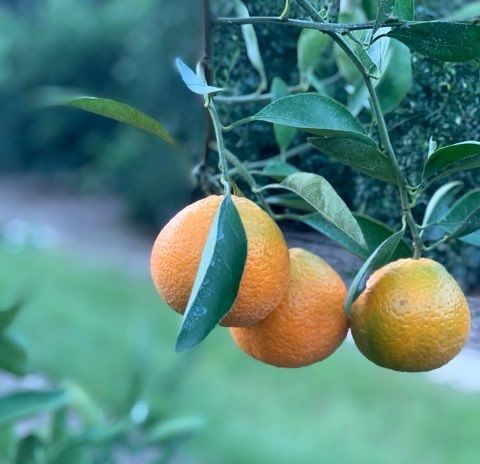
Credit: Kim Jones, Florida Georgia Citrus, Monticello, FL
'Miho' Satsuma. Season of maturity: October to November. Seeds: 0–2, rarely present. This cultivar was produced by controlled pollination of ‘Miyagawa’ Satsuma through seed production. Fruit have the usual orange flesh color and a loose peel as well. It was imported from Japan, then evaluated and tested at the Texas A&M Research and Extension Center.
'Obawase' Satsuma. Season of maturity: October to November. Seeds: 0–6, but rarely present. This cultivar is closely related to the ‘Owari’. Both consist of fruit with similar skin color and seed count, but the fruit of ‘Obawase’ are larger than most of the satsumas.
'Okitsu' Satsuma. Season of maturity: November to December. Seeds: 0–4, but rarely present. This is another closely related cultivar to the ‘Owari’. They only differ in fruit taste and maturity. ‘Okitsu’ fruit taste sweeter and mature earlier than the ‘Owari’ cultivar but only in specific growing conditions.
'Armstrong' Satsuma. Season of maturity: October to December. Seeds: 0–4. ‘Armstrong’ is a California variety.
'Seto' Satsuma. Season of maturity: October to November. Seeds: 0–2, rarely present. This cultivar was produced by controlled pollination of ‘Miyagawa’ Satsuma through seed production. Fruit have the usual flesh color of orange and a peel color of red-orange. It was imported from Japan, then evaluated and tested at the Texas A&M Research and Extension Center.
'Kara' Satsuma. This cultivar is a hybrid between the common ‘Owari’ and a variety of tangerines. Due to this mix, it has fruit peel and flesh lighter than the others. Also, it produces more seeds in its medium-sized fruit.
Rootstocks for Satsuma Mandarin
Rootstocks are a tree’s underground root system for obtaining the necessary soil, water, and minerals for the aboveground scion. Rootstock plays an important role for environmental stress tolerance, as well as insect-pest and disease resistance. Stronger and healthier root systems improve yield and fruit quality. Below is a list of typical rootstocks connected to these scions and their characteristics.
Trifoliate orange (Poncirus trifolata (L.) Raf) is the most used rootstock for satsuma mandarins, especially in cool climates where maximum cold tolerance is needed. However, in Florida, where the winters can be relatively short and interrupted by brief periods of warm temperatures, trifoliate orange does not provide consistent protection from cold south of Gainesville.
Trifoliate orange grows well on fertile clay-to-loamy type soils. It does not develop a very deep or wide-ranging root system and is poorly adapted to saline or calcareous conditions, but its resistance to foot rot, a soil-borne disease, makes it a good choice for soils with poor drainage. Trifoliate orange, however, is susceptible to exocortis (virus-like disease), blight (unknown cause), and the burrowing nematode; some selections are resistant to the citrus nematode. Many selections of P. trifoliata are available, including a dwarfing rootstock named 'Flying Dragon'.
'Swingle' citrumelo is a cross between P. trifoliata and 'Duncan' grapefruit (Citrus paradisi Macf.). 'Carrizo' citrange is a cross between P. trifoliata and Washington Navel (Citrus sinensis L.). Satsumas are often propagated on 'Carrizo' and especially 'Swingle' rootstocks. This is because budding and early tree growth are better for satsumas on 'Swingle' compared to P. trifoliata. The cold tolerance potential of satsuma on 'Swingle' or 'Carrizo' rootstocks compared to P. trifoliata has not been adequately compared, although they are believed to be less cold tolerant than when grafted on P. trifoliata. We have observed 'Navel' on 'Carrizo' and 'Owari' as well as 'Brown Select' on 'Swingle' to withstand 14°F without appreciable cold injury at the North Florida Research and Education Center in Quincy, FL, when fully cold acclimated.
Performance of Satsumas in North Florida
A 0.66-acre satsuma planting was established in 2004 at the North Florida Research and Education Center in Quincy, FL, consisting of 'Owari' or 'Brown Select' scions on either Poncirus trifoliata 'Flying Dragon' or 'Rubidoux' rootstocks. Each scion or rootstock was represented 19 to 28 times in a randomized block design. Citrus trees were spaced 15 feet in a row and 20 feet between rows. Soil type was an Orangeburg loamy fine sand. Irrigation was provided by microjet emitters. Fertilizer (10N-10P-10K with micronutrients) was generally applied every six weeks beginning in March and ending in early August. Tree height and tree width (in N-S and E-W directions, respectively) was determined in 2010, 2012, and 2014; canopy area was also calculated. Satsumas were harvested in late November through early December. Fruit weight, soluble solids, and pH were determined on a 20-fruit sample from each tree. Young (after first-to-fourth leaf growth; 1–2 years old) trees received soil mounding up to a height of 1 ½ feet, and microjet freeze protection on young trees was deployed when temperatures dropped to less than 20°F. Freeze control methods were not used after the winter of 2008/2009.
Satsuma trees on 'Rubidoux' generally reached full canopy size by 2010 (sixth leaf) and fully occupied the 15 x 20 feet spacing, whereas trees on 'Flying Dragon' (a dwarfing rootstock) remained small (Table 1). 'Brown Select' trees were larger than 'Owari'. The reduction in tree size in 2014 compared to 2012 was due to necessary pruning as preventative measures. Some low-lying limbs threatened fruit to contact the ground, and for 'Rubidoux' only, limbs hanging between rows blocked easy passage of farm equipment. Yield per year averaged 264 lbs/tree (19.2 tons/acre) for 'Brown Select'/'Rubidoux', 218 lbs/tree (15.8 tons/acre) for 'Owari'/'Rubidoux', 143 lbs/tree (10.4 tons/acre) for 'Brown Select'/'Flying Dragon', and 107 lbs/tree (7.8 tons/acre) for 'Owari'/'Flying Dragon'. When calculating yield on the basis of tree size, yields were often similar for trees on the two rootstocks (‘Rubidoux’ and ‘Flying Dragon’), suggesting a high-density satsuma orchard on 'Flying Dragon' can produce yields per acre similar to 'Rubidoux' planted for a standard tree density. Since trees on 'Flying Dragon' will seldom exceed seven feet in height, mature trees can easily be harvested without ladders. Average fruit weight ranged from 139 to 154 g, which was slightly higher for 'Brown Select' than 'Owari' and higher for 'Rubidoux' than 'Flying Dragon'. The soluble solids and pH of juice was usually about 10° Brix and 3.73, respectively. 'Owari' was sweeter than 'Brown Select'. Visible symptoms of cold injury did not occur in response to minimum winter temperatures of 14°F–15°F; however, some minor limb dieback occurred after a freeze (22°F) on November 19, 2014, when trees were not cold-acclimated. All satsuma cultivars grow and produce very well in north Florida. In addition, cold weather favors the development of good fruit color and taste. Therefore, there is good potential for the expansion of a satsuma production from a niche to an industry in north Florida.
Table 1. Average tree canopy area, yield, fruit size, fruit soluble solids, and fruit pH from 2009–2014 of 'Brown Select' and 'Owari' satsuma budded on P. trifoliata 'Flying Dragon' and 'Rubidoux' rootstocks.